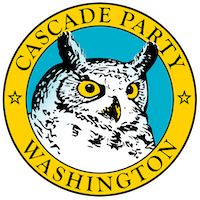
Cascade Party
A new path in Washington State politics.

A new path in Washington State politics.
Transportation
Replacing the Interstate 5 Bridge: Max Rail or Autonomous Rubber Tires and a Flying Future?

The Coumbia River crossing between Vancouver, WA and Portland, OR is long overdue for the needs of the 21st Century. There is concensus with the need for a new bridge and approaches. The controversy stems over rail as public transportation.
By Johann Peters. (November 21, 2025)
Anyone who has ever crept over the I-5 Bridge connecting Washington to Oregon at rush hour knows it’s a relic. The narrow steel span, built in 1917 and 1958, sighs under modern traffic, while to the east, its younger cousin I-205 bridge stands taller and wider.
When the old span drawbridge lifts, the whole commute seems to groan. Its replacement is long overdue, and no one on either side of the river pretends otherwise. The question is, what kind of bridge do we build? The answer: What kind of future do we want?
A new bridge is basically an opportunity to untangle a system where major state routes all converge into a single choke point. These routes serve industrial areas on both sides of the Columbia, carrying freight and workers fighting through outdated ramps and merge points every day.
Fixing the approaches offers to ease congestion by correcting the compounding pressure built around the river crossing.
The Approaches Cost More Than The Bridge
A clearer look at the numbers shows that the bridge itself is only a fraction of the total price. The approaches are the most complex and labor intensive portion of the project.
Independent reviews estimate the river span itself at roughly 1 to 1.5 billion dollars, or about one fifth of the full program. The far larger cost lies in the approaches — which could run $3.5 to $5 billion once all interchange rebuilds and corridor widening are included.
Early planning, design and consulting have already exceeded 200 million dollars and continue to rise. Right-of-way and property acquisition costs will add further expense, though the program has not publicly broken out those figures in recent fact sheets.
As with most mega-projects the price will not stay static.
By the time a final decision is reached and contracts awarded, the total cost could easily rise to the upper end of the range or beyond because of inflation, construction escalation and ongoing design adjustments.
The Light Rail Divide
Extending Portland’s Max light rail into Vancouver is divisive.
US Rep Marie Gluesenkamp Perez supports extending Max saying rail would help reduce congestion and support sustainable growth through federal cooperation.
Some Washington officials disagree.
State Representative John Ley argues transportation spending should save travel time and reduce congestion which he says the current proposal fails to do.
The Camas city council unanimously passed a resolution opposing the light rail component over concerns it would burden residents with high costs and little benefit.
An article in the Post-Record mentions how leaders of the Interstate Bridge Replacement Program warned the Camas council that building a bridge without rail, at this point, would mean costly delays due to redesigns. These officials also cited their own poll where "light rail had 69 percent support in Vancouver and 57 percent support in Clark County excluding Vancouver residents’ responses."
Estimates show Max rail could add between 1.32 and 1.99 billion dollars to the project plus 6.8 million dollars per year to operate.
Government Integrity Questions
The debate over light rail got shady in March when Clark County Councilor Michelle Belkot was removed from the C Tran Board — one day after voting against language that would allow local tax dollars to fund light rail operations.
Her lone vote broke 4 to 1 on the council. Belkot was removed from the C Tran board by her council colleagues within 24 hours.
A Skamania County Sheriff’s Office investigation later found her removal invalid and recommended fines for the four councilors. The report concluded the council violated the Open Public Meetings Act by taking action without public notice, discussion or legal authority.
The findings renewed calls for transparency. When public agencies make decisions behind closed doors, trust in the entire bridge process erodes.
Rapidly Advancing Technology
Transit advocates continue to support rail despite its origins in the 19th century. Skeptics point to Sound Transit’s repeated and massive cost overruns and construction delays.
Technology is advancing quickly and many believe the bridge should be designed for a future that may rely less on rail and more on flexible systems.
Autonomous buses and self driving cars could transport people efficiently without committing the region to the fixed cost of rail.
Public / private partnerships could help fund modern alternatives. Companies such as Waymo, Tesla and Cruise operate autonomous vehicles elsewhere.
Electric vertical takeoff and landing aircraft are currently in the process of federal certification. These promise quiet, short distance flights between hubs at a fraction of the cost of traditional aircraft.
Building a Bridge for Today and Tomorrow
People want a bridge that works, a process guided by transparency, accountability and pragmatism. We’ve watched Seattle’s Sound Transit projects swell from early low billion estimates into more than 12 billion dollars while schedules slipped year after year.
Washington and Oregonian can build a bridge that gets us across the river without crossing our fingers that we’ll miss a traffic jam. If the region can balance today’s needs with tomorrow’s possibilities, the new bridge can do more than span the Columbia — it can show that we built something ready for the future.
Johann Peters is on the Cascade board of directors serving in one of the postions for district 3/6.